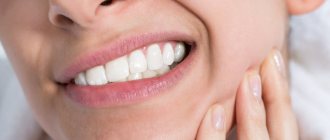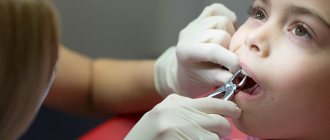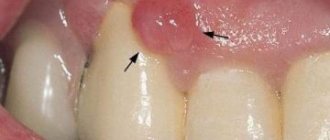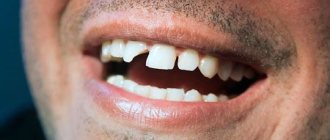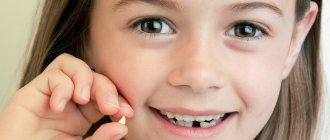What is Priestley plaque on teeth?
This is a dental problem that occurs in children. In this condition, deposits are found on the enamel of the teeth. Dark plaque on a child’s teeth can be black or brown, sometimes with a light or pearlescent tint. As a rule, it is located as a thin border along the lower edge of the teeth closer to the gums. But plaque can also cover a large area of the tooth or look like a small spot on the enamel. Most often, dark deposits appear on the inside of the teeth, less often in the interdental space or on the outer surface of the teeth.
Photo courtesy of InWhite Medical Clinic
How to detect dark plaque in time
- regularly examine the child’s oral cavity independently;
- do not postpone scheduled visits to the dentist.
It must be taken into account that Priestley plaque on the teeth often accumulates slowly, which is why the child gets used to the stains on the enamel and does not tell his parents about them. Darkening of teeth can occur quickly, literally overnight. Reactive appearance most often occurs during illness, accompanied by intoxication, dehydration and increased body temperature. This is due to the fact that the child’s body reacts sharply to various changes in diet, the functioning of internal organs and in external conditions.
Deposits most often occur at the age of 2-3 years. However, they can also appear on the very first milk teeth of a one-year-old child. Or it could affect the baby teeth of a younger teenager who haven’t had time to change. The darkening may also spread to permanent teeth.
Prevention of dental plaque in children
Prevention of dental diseases should begin with the appearance of the first milk teeth. The following recommendations must be followed:
- brush the newborn’s teeth from the moment of teething using a special silicone fingertip;
- by the age of 2-3 years, accustom the child to cleaning the oral cavity independently in the morning and evening;
- change your baby’s toothbrush every month, buy hygiene products intended for children of the appropriate age;
- Bring your child for a preventive examination to the dentist every 4 months, even if there is no plaque or other symptoms;
- limit the consumption of sweets, include healthy foods without fast carbohydrates and with minerals in the children's menu.
The baby may also be bothered by other symptoms that he cannot tell an adult about. Therefore, bring him for examination, regardless of what color plaque has formed on his teeth.
Why does a child have black plaque on his teeth?
The main problem with the appearance of Priestley plaque on teeth is not that it causes bad breath, looks unsightly, or cannot be removed independently without the help of a hygienist. Priestley's plaque is a signal that something has changed in the child's body, due to which non-dangerous bacteria began to actively multiply, creating deposits. And for high-quality treatment and prevention of the development of diseases, it is necessary to find out why black plaque forms on the teeth, the reasons for the appearance of beneficial living conditions for bacteria.
Possible causes of plaque:
➢
diabetes;
➢
genetic feature or hereditary predisposition;
➢
thyroid diseases;
➢
incorrectly selected hygiene products;
➢
parasite infection.
Dysbacteriosis.
Disruption of the gastrointestinal tract can occur due to malnutrition, food poisoning, immaturity of the digestive system, taking antibiotics or chronic diseases of the stomach, liver, and intestines.
Caries.
Due to the fact that parents usually do not brush their baby’s first teeth, yellow plaque begins to accumulate on the enamel, which over time can cause caries. Irregular or insufficiently high-quality tooth brushing by the child himself also leads to the formation of caries. Carious lesions create a favorable environment for the growth of bacteria, which causes Priestley plaque to appear on baby teeth.
Dehydration.
Due to dehydration due to various reasons, the body cannot produce enough saliva to wash the teeth and remove food particles. Because of this, bacteria begin to multiply faster, and a dark plaque forms on the child’s teeth. Therefore, it is important to ensure that your baby gets enough fluids, especially in hot weather or during illness.
Hypoplasia of tooth enamel.
Some children have underdeveloped top layer of enamel. It is weakened and unable to perform a protective function.
Disorders of dental development in the prenatal period.
Dental buds may be damaged during development due to viral infections suffered by the mother, calcium deficiency, iron deficiency, or taking certain medications.
Improper functioning of the immune system.
Malfunctions in the immune system can affect the body's ability to suppress bacterial activity.
Malocclusion.
If a child has a malocclusion, the load on the jaw when chewing is distributed unevenly, which is why some of the teeth receive increased load, but are cleansed with solid food: carrots, apples. And unused teeth become covered with plaque.
Tetracycline
This is an antibiotic often used for colds. But it is generally known that it should not be consumed by children under 9 years of age. Because it stains all the layers of the tooth forming in the jaw and after eruption the tooth turns out to be characteristically colored: with a grayish tint, faded. Sometimes the coloring occurs in stripes or lines. This depends on the stage of tooth formation at the time of exposure to the damaging factor.
This color can only be eliminated by long-term courses of teeth whitening for adult patients.
Diagnosis of Priestley plaque on teeth
If darkening is detected on the enamel of a child’s teeth, you must contact a dental clinic.
The specialist will:
✔
inspection;
✔
laser diagnostics to determine the depth and size of the lesion;
✔
anamnesis collection.
After a conversation with the parent and child and collecting an anamnesis, the pediatric dentist will immediately prescribe treatment or conduct an additional examination. You should not neglect it - it is important for a specialist to find out why the child has black plaque on his teeth. Only after this will he be able to provide quality treatment.
Consequences
Often parents consider the problem of black plaque to be purely aesthetic and are in no hurry to contact a specialist. Darkening of the enamel indicates an imbalance in the baby’s body. If you do not pay attention to dark stripes and spots, consequences are possible, namely:
- The occurrence of diseases such as caries, gingivitis, periodontal disease , which can lead to tooth decay. It is highly undesirable to remove them in early childhood: this can cause malocclusion.
- The child will have bad breath , which will lead to disruption of socialization.
- Tartar may appear , bleeding gums may occur, tooth sensitivity or inflammation of the gum tissue may occur.
On a note ! According to research, dental problems in children appeared relatively recently - 8 - 10 thousand years ago due to the transition of humanity to other methods of cooking.
Additional protective measures for Priestley's raid
It is possible that Priestley's plaque on the teeth appeared due to an infection and, as a result, a temporary deterioration in the functioning of the immune system. But it is necessary to make sure that there are no serious and dangerous deviations in the child’s health. Therefore, if dental plaque is detected, the dentist will recommend taking additional measures:
- get tested for the presence of parasites in the body;
- consult a gastroenterologist;
- take tests to check the level of iron and calcium in the body;
- check your blood sugar levels.
These measures will help identify the problems that are causing plaque to form on your teeth.
Questions for the doctor
Teething
Tell me, my son has erupted one upper incisor, and in place of the second, the gums have slightly swollen and a dark spot has appeared. Do I need to take any measures or just wait until the tooth erupts?
The appearance of an eruption cyst at the site of a future tooth is a common occurrence. And usually such a cyst goes away on its own, without outside intervention. But to monitor the condition of the child’s teeth and gums, it is necessary to show him to a pediatric dentist.
Hematoma on the gum
My daughter has a small black dot under one of her lower incisors. We can see a doctor only in a week. What could this be and does it need to be treated somehow?
If, apart from the black dot on the child’s gum, nothing bothers him, there is no swelling or redness, then most likely this is the result of mechanical damage to the gums from a fall or impact. Such a hematoma usually resolves on its own within a few days, so no additional therapeutic measures are required.
How to remove black plaque on teeth
It is impossible to remove dental plaque at home. Moreover, the use of abrasive agents and intense exposure to teeth with a brush can cause an increase in dental problems: thinning or damage to the enamel, trauma to the gums or mucous membrane.
Priestley's plaque on children's teeth can only be removed in a well-equipped dental clinic. The specialist will:
- professional teeth cleaning;
- If necessary, treat the teeth with a remineralizing composition.
If plaque formation is caused by dental problems, additional treatment may be prescribed, including bite correction.
The doctor will also select a home hygiene kit that is ideal for the child: a toothbrush of the correct shape and hardness, toothpaste with the optimal composition, and mouth rinse. Additionally, the hygienist will teach the child how to brush their teeth correctly and will talk about the need for quality oral care.
Taking into account the causes of the disease, the dentist may prescribe additional treatment measures, for example, recommend dietary supplements, dietary nutrition, avoidance of drinks and foods with dyes that affect the color of the enamel.
Basics of treatment and prevention
If a child has black spots on his gums, then even if the baby is not bothered by this, you should definitely show him to the pediatric dentist. After all, only a doctor will be able to assess the condition of the oral cavity and prescribe the necessary treatment, depending on the cause of this pathology. More information about the treatment of black spots on gums in children is described in the video in this article.
The main requirement for parents to maintain the health of their child’s teeth and gums is to follow the rules and preventive measures:
- You need to ensure that your child regularly brushes their teeth thoroughly;
- Maintain oral hygiene in babies before teething, using special silicone brushes for the cheeks and tongue, or disinfectant wipes;
- monitor the quality of the child’s food, do not allow the temperature of the food to be too hot or cold;
- undergo timely preventive examinations with a pediatric dentist and pediatrician.
If any symptoms of dental and gum disease appear in children, such as bleeding, swelling, white or black spots on the gums, you should not self-medicate. This can only aggravate the situation, because in the initial stages any pathology is much easier to treat. And if you try to self-medicate, you will only waste precious time.
Category Children Published by Mister stomatolog
